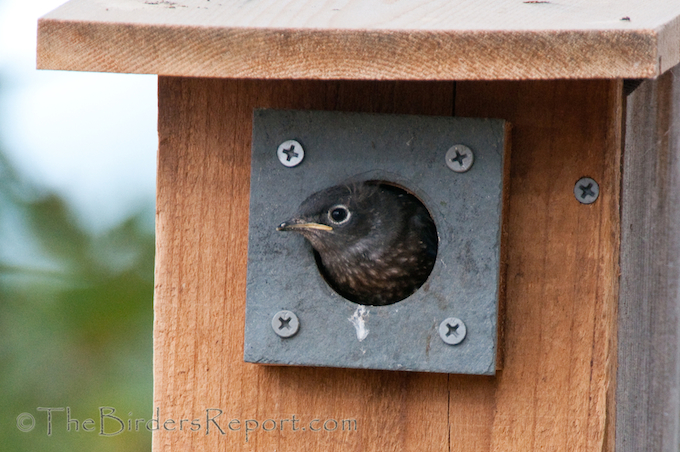 Western Bluebird Nestling (Sialia mexicana) photos by Larry Jordan (click photos for full sized images)
Western Bluebird Nestling (Sialia mexicana) photos by Larry Jordan (click photos for full sized images)
Being the conscientious Bluebird Trail monitor that I am, I noticed Friday, on my way home from work, as I approached this nest box one of the nestlings was staring back at me out the entrance hole. I knew it had to be close to fledging time because I check the boxes often enough to know when the eggs hatch and therefore when the nestlings should be ready to fledge.
You never want to approach a nest box when it is close to fledging time because you don’t want the nestlings to fledge prematurely. Western Bluebirds usually fledge at around 20 days old.
So I waited until the next morning and went back to the nest box in question. They were still there. I set up at a safe distance hoping to watch the entire fledging process from the beginning.
When I arrived at around 7:30 am, the female adult was in the tree adjacent to the nest with food for the nestlings. In my experience, most birds seem to fledge in the morning which makes sense to me. That way the young birds have most of the day to get used to the real world!
I heard an Ash-throated Flycatcher nearby, another cavity nesting species that uses the bluebird houses. I was rather surprised when I witnessed the Flycatcher chasing the momma Bluebird away from her nest site. It worried me a little bit but then I thought maybe the Ash-throated Flycatcher had chosen a nest site in one of the natural cavities in the nearby oak trees.
Mamma Bluebird snuck back to the nest box and fed the nestlings the tidbit she had in her beak and took off, presumably for more food. At this stage in the nesting process the young are fed about 10 times per hour which, if your math is good, equates to about every six minutes.
But wait. What’s going on with all of these Violet-green Swallow (Tachycineta thalassina) images? Violet-green Swallows seem to appear out of nowhere in my experience and as I am standing there, all of a sudden, there they were! Three or four Violet-green Swallows circling me, the oak trees and the nest box!
Both Ash-throated Flycatchers and Violet-green Swallows are cavity nesting birds that will use bluebird nest boxes. I knew that they were around because I have both species currently occupying some of my other nest boxes. However, I was not aware that they were bold enough to approach and inspect occupied boxes.
At one point a swallow actually perched atop the nest box and looked down as if it was expecting to see a youngster sticking its head out the entrance hole.
In the meantime, the brilliantly colored male Western Bluebird was taking his turn bringing food to the nestlings.
At this point however, the adults were only bringing food to the nest box on some of the visits. Some trips to the nest were taken with empty beaks.
This is the point at which the adult Bluebirds try to coax the nestlings out of the nesting cavity into our world. They perch on nearby branches and call t0 them, urging them to come out of the only home they have ever known.
The young birds stick their little heads out the entrance to the birdhouse over and over again, hearing all the other birds calling around them but pinpointing that special call from their parents. Wondering if mom and dad are going to bring more food and in this case, what all those Violet-green Swallows are doing flying toward the house.
This youngster finally decided it was time and took the plunge into this big wide world. He or she flew about fifteen feet to the branch of an oak tree directly in front of the birdhouse. And, as it is always the case, as soon as the first nestling leaves the nest, another one pops its head up to look out to see where its nest mate has disappeared to.
I filmed this monumental event that goes on daily across the globe, young birds leaving their nests, depending on their parents to teach them the ways of the world. I have condensed the three hours I observed watching the first three of the five nestlings fledge into a six and a half minute video.
You will see the female Western Bluebird make a few trips to the nest with food for the chicks and then again without food. She comes back and lands on the roof of the house a few times, then perches nearby. The male also comes to the nest box without food as the nestling opens its mouth thinking it will be fed. In the meantime the Violet-green Swallow cruises by.
There is video of the first nestling perching for the first time on a tree branch and watching the swallows flying overhead. Listen for several other bird species calling in the background and see if you can identify them.
After all of this, head on over to The Bird D’pot and Wild Bird Wednesday to see all the other bird photos from around the world!

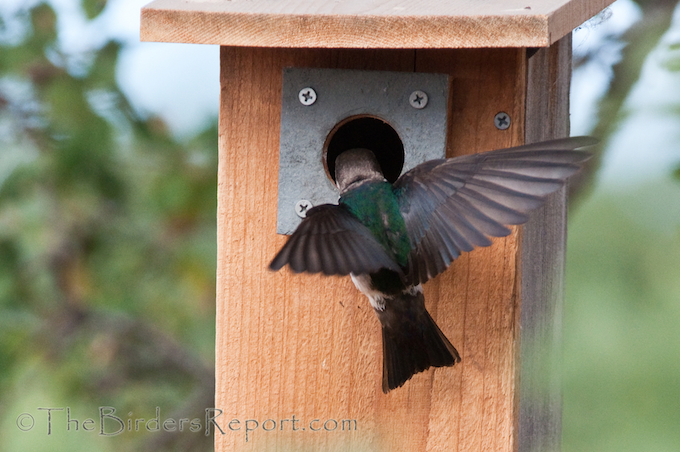
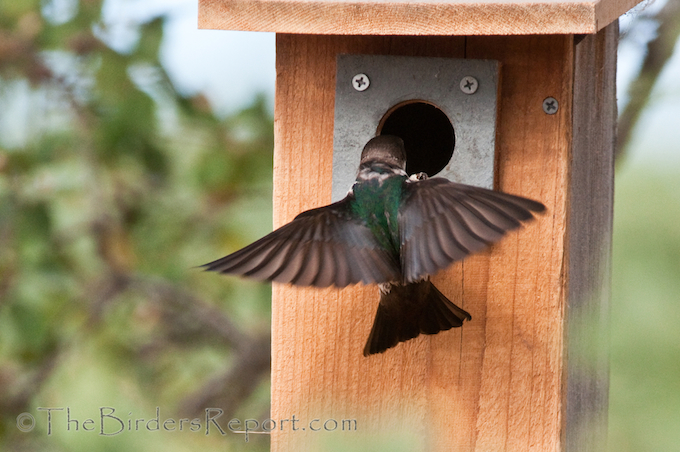
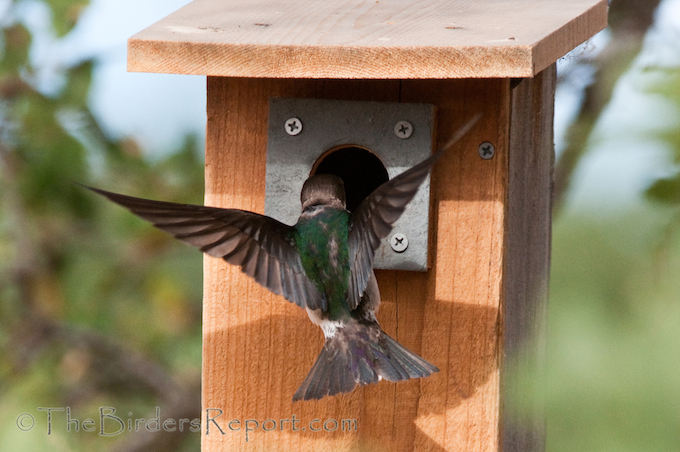
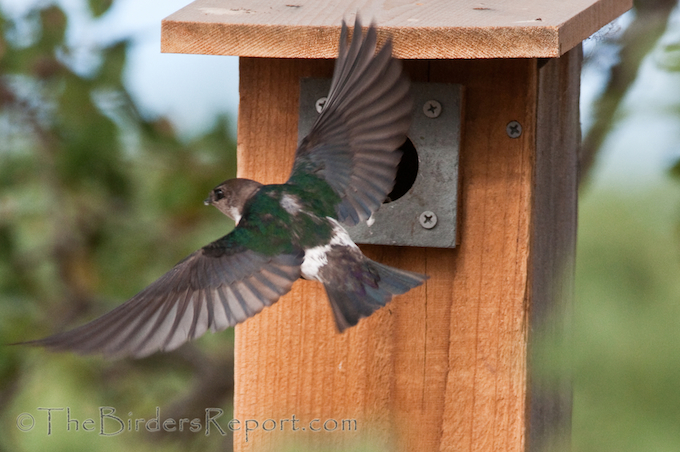
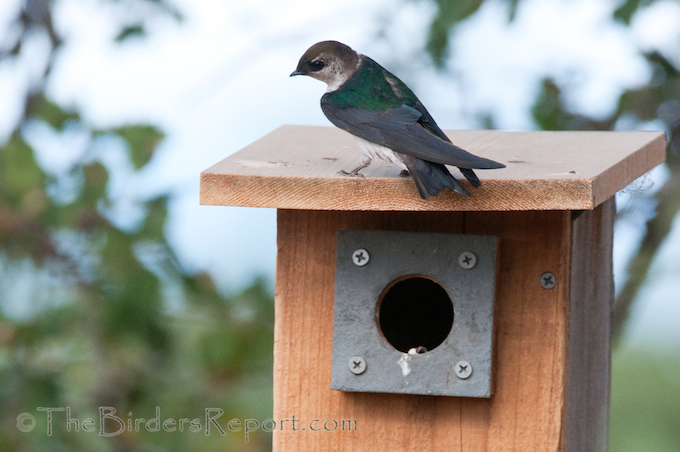
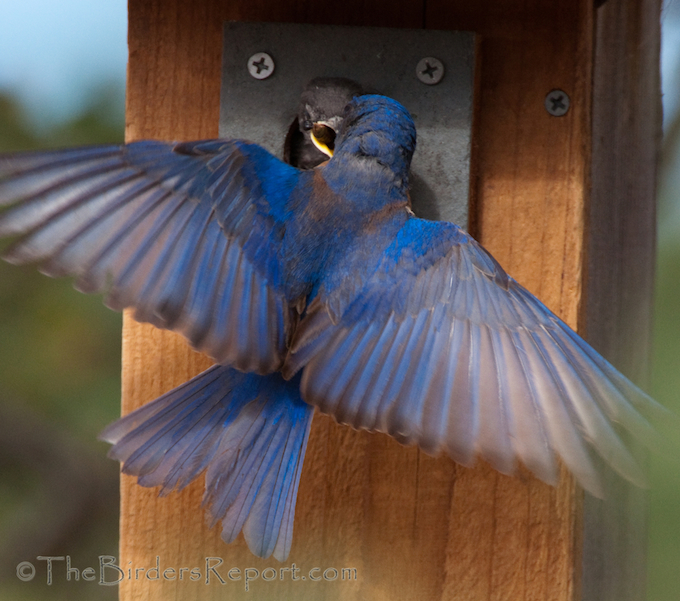
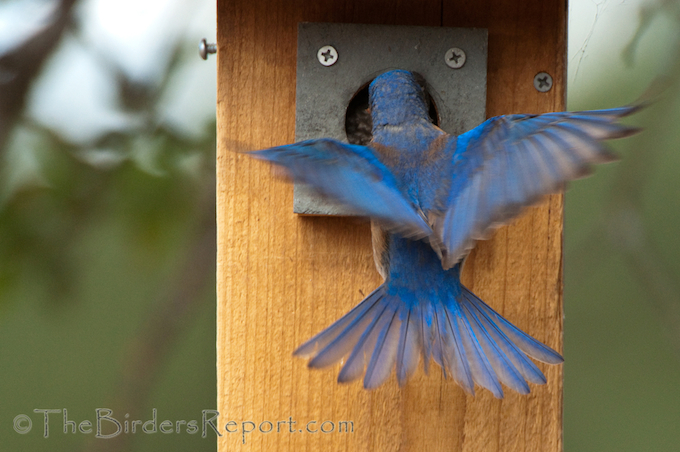
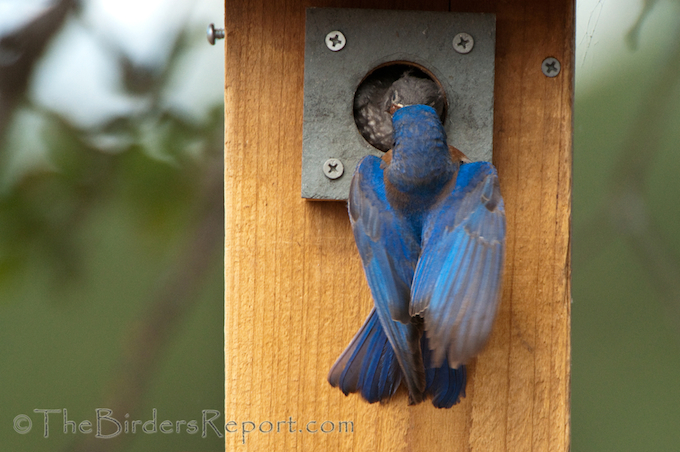
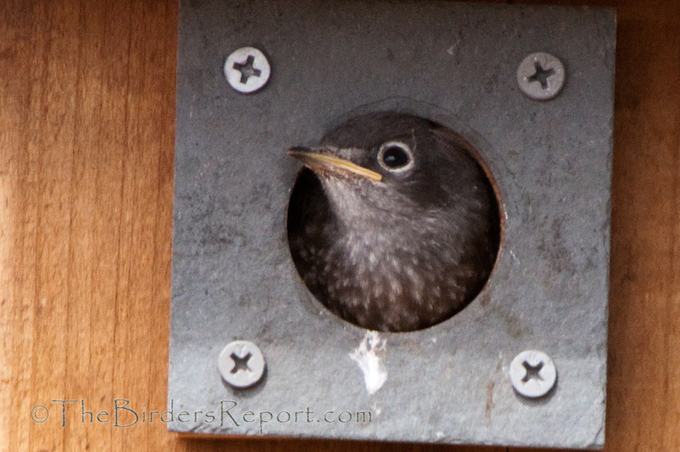








Comments on this entry are closed.
the swallows were house-hunting while the occupants were home (without a realtor, i might add!) 🙂
Wonderful post and images Larry, that first image really appealed to me. Thanks for bringing up the info about not approaching nests when birds are about to fledge. This time of the year makes me nervous for the young birds because so many people try to get nestling and chick images.
Wow – what a great story and such beautiful photos!
Wow, these are marvellous captures!
Yes, I’m with Mia on that great info … about keeping your distance. Larry, this has to be one of the most precious videos I’ve seen in a while! And what an incredible series with the Violet-green Swallow interlude. I love this post. Thank you for spending those three hours and the subsequent editing time, putting this together for us. (I tell my friends that fledgling season is stressful for me, too. It’s so hard to watch those first hours and days in that vulnerable state.)
On the other birds, I know I heard a Mourning Dove. Also an Acorn Woodpecker? I can’t identify the consistent chirp that’s present throughout … would love to know.
@Theresa it is interesting to see the reactions of some birds when another species is checking out their occupied house!
@Mia thank you! It is VERY important that people understand the concept of giving wildlife their space. As you have stated so many times on your blog, if you cause a bird to fly or alter their behavior, you are too close!
@Tami thank you very much for your comment!
@Karen thank you, I appreciate it!
@Ingrid thank you so much! It was great fun watching all the interactions between the species and the nestlings and their parents too.
One of the first calls at the beginning of the video is the gurgling call of the Ash-throated Flycatcher. And yes the Acorn Woodpecker is in there and the California Quail. I believe the constant chirp you speak of are the Bluebird adults and nestlings!
Also I want to alert my readers to the fact that both you and Mia McPherson mentioned keeping distance between yourself and the wildlife. These two women are poster children for photographic and wildlife ethics. You can read about Ingrid’s philosophy here, and Mia’s here.
Great photos and video. Wonderful to see little birds take off like this.
Great photographs, Larry, I particularly like the ones of the Violet-green Swallows.
Great post, Larry! The Violet-Green Swallows are beautiful. I hope the fledglings survive and all is well. Loved the photos, happy birding!
Fabulous shots! I posted swallows today as well!
My WBW
Great sequence Larry. Boom & Gary of the Vermilon River, Canada.
Amazing images Larry!! Love the colors of both bird species and the fact that they’re so close up…why I can see each detail of each feather. Too bad it was already ‘occupied’.
Superb article, photographs and video, Larry! Very nice work!
A great tutorial on a fledging Bluebird.
I’ve been in the field quite a bit, lately, working on Florida’s current breeding bird atlas project. I echo everything that’s already been said about keeping ones distance, not only from nest sites but from birds engaging in courtship, too. It’s tough enough for them out there, they don’t need us clumsy humans intruding! That’s why we have binoculars and big lenses! Or a chair on a porch!
Nice post and great images Larry. We’ve had our first cycle of baby bluebirds and about to have our second cycle. I noticed the last few days that the male bluebirds are flying in the sticks, pine needles, etc. in and out of the box all day. The females are sitting around watching. I wanted to go fill up the mealworm feeder but decided not too since I would scare them.
I visit your site often and love your post.
It’s Bluebird Nesting Time Again!
Michael
@Michael thank you very much! With the 100 degree heat here in California, our nesting season is about over. I’m glad to here that you have having a great Bluebird season back there in South Carolina! Your wood products are gorgeous!
thank you Larry,
I am having problems getting the bluebirds to the mealworm feeder. From yourpictures it looks like you might be using a mealworm feeder. How long did it take the bluebirds to find the feeder?
Michael